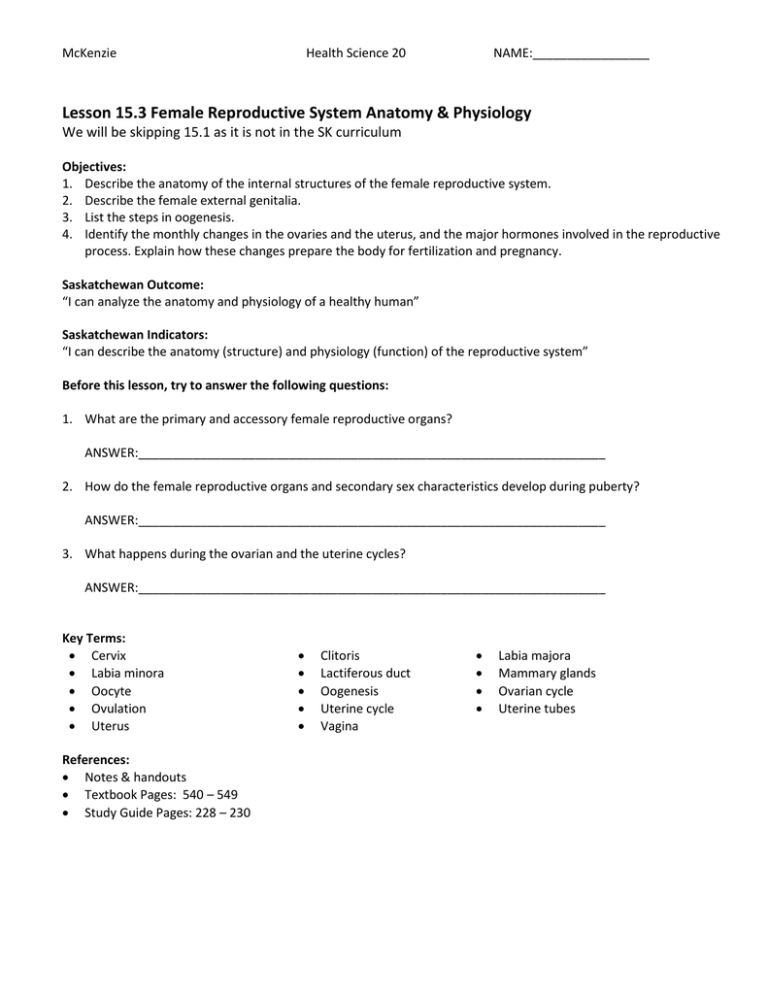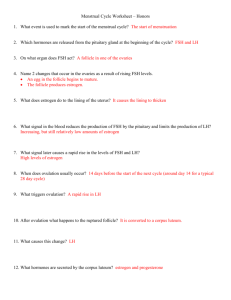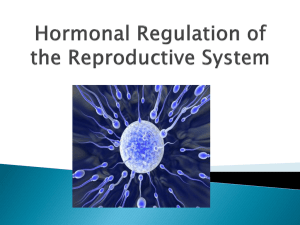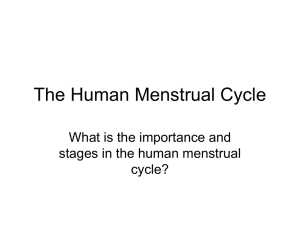Lesson 15.3 Female Reproductive System Anatomy & Physiology
advertisement

McKenzie Health Science 20 NAME:_________________ Lesson 15.3 Female Reproductive System Anatomy & Physiology We will be skipping 15.1 as it is not in the SK curriculum Objectives: 1. Describe the anatomy of the internal structures of the female reproductive system. 2. Describe the female external genitalia. 3. List the steps in oogenesis. 4. Identify the monthly changes in the ovaries and the uterus, and the major hormones involved in the reproductive process. Explain how these changes prepare the body for fertilization and pregnancy. Saskatchewan Outcome: “I can analyze the anatomy and physiology of a healthy human” Saskatchewan Indicators: “I can describe the anatomy (structure) and physiology (function) of the reproductive system” Before this lesson, try to answer the following questions: 1. What are the primary and accessory female reproductive organs? ANSWER:____________________________________________________________________ 2. How do the female reproductive organs and secondary sex characteristics develop during puberty? ANSWER:____________________________________________________________________ 3. What happens during the ovarian and the uterine cycles? ANSWER:____________________________________________________________________ Key Terms: Cervix Labia minora Oocyte Ovulation Uterus References: Notes & handouts Textbook Pages: 540 – 549 Study Guide Pages: 228 – 230 Clitoris Lactiferous duct Oogenesis Uterine cycle Vagina Labia majora Mammary glands Ovarian cycle Uterine tubes McKenzie Health Science 20 NAME:_________________ 15.3 Female Reproductive System Anatomy and Physiology The Female Reproductive System McKenzie The Ovary Label the steps in the production of the egg Health Science 20 NAME:_________________ McKenzie Health Science 20 NAME:_________________ Reproduction 3: The Female Reproductive System Although the male and female reproductive structures are homologous in their design, they appear very different from each other. The testes produce several hundred million gametes (sperm) per day, while the ovaries usually produce only one OVUM (egg) per month. Male gametes are produced throughout a male’s sexually mature existence. Female gametes develop from follicles. A female is born with about two million follicles, but none are produced after birth. In fact, once a female reaches puberty, the number of follicles may be reduced to about three to four hundred thousand. Each month, one of these matures. Use figures 21.6 to label the following diagram. * Note: The opening of the urethra is separate from the vagina. Unlike males, the urinary and reproductive tracts are separate. McKenzie Health Science 20 NAME:_________________ Oogenesis Oogenesis is the process of the development of the OVA (egg). As was mentioned, a sexually mature woman has 400 000 or less (depending on age) FOLLICLES in her OVARIES. Oogenesis follows the following steps: 1. In a PRIMARY FOLLICLE, the PRIMARY OOCYTE undergoes an unequal meiotic division (meiosis I). This produces two cells each with 23 chromosomes. Meiosis II does not occur until the egg is fertilized. 2. The primary follicle now develops into a SECONDARY FOLLICLE which contains the newly formed secondary oocyte. 3. The secondary follicle now develops into the GRAAFIAN FOLLICLE which houses the secondary oocyte in a fluid filled space. 4. Pressure increases within the Graafian follicle until the secondary oocyte (often called an egg) is released. This is referred to as OVULATION. 5. The remaining follicular structure (without an oocyte) develops into a CORPUS LUTEUM which is a hormone secreting structure. 6. If pregnancy does not occur, the corpus luteum degenerates after about ten days. If pregnancy does occur, the corpus luteum persists for about 3 to 6 months and secretes the female sex hormones estrogen and progesterone. 7. Once the egg is released it must cross a small space between the ovary and the OVIDUCT (Fallopian tube). The FIMBRIA sweep over the ovary at the time of ovulation and push the egg toward the oviduct. 8. The egg is pushed down the oviduct by microscopic cilia which line the tube. It is during this journey the egg may be fertilized by a sperm. 9. After a few days the ovum passes from the oviduct into the UTERUS. The lining of the uterus is specially designed to receive a fertilized egg. 10. If fertilization has occurred the egg implants in the uterine wall. If fertilization has not occurred, there is no implantation. Complete the Lesson 1. Read p. 540 – 549 in your textbook 2. Make flashcards for A-L on Female Reproductive System Diagram (label on one side, function on other) McKenzie Health Science 20 NAME:_________________ McKenzie Health Science 20 NAME:_________________ Reproduction 4: Regulating Female Hormone Levels Hormone regulation in females involves the following glands and hormones: 1. Hypothalamus: secretes GONADOTROPIC-RELEASING HORMONE (GnRH). 2. Anterior Pituitary: secretes FOLLICLE STIMULATING HORMONE (FSH) and LUTEINIZING HORMONE (LH). These are the gonadotropic hormones. 3. Ovaries: Secrete ESTROGEN and PROGESTERONE. These are the female sex hormones. Oogenesis (development of the egg) is coordinated by the build up of the lining of the uterus. This build up prepares the uterus for implantation should fertilization occur. These two coordinated cycles are called the OVARIAN and UTERINE cycles. 1. OVARIAN CYCLE The gonadotropic and sex hormones in females are not present in constant amounts. They are secreted in different amounts during a monthly OVARIAN CYCLE which lasts about 28 days. It is divided into two phases with OVULATION occurring in the middle. Follicular Phase (Days 1 to 13): Follicle Maturation Begins when estrogen levels are low. The HYPOTHALAMUS responds to LOW estrogen levels by secreting GnRH. GnRH stimulates the ANTERIOR PITUITARY GLAND to secrete LH and FSH. LH and FSH travel (in the blood) to the OVARIES. This is where they act. FSH (and to a lesser extent LH) stimulates the maturation of one follicle in an ovary. As the follicle matures it secretes ESTROGEN. As estrogen levels rise, they exert NEGATIVE FEEDBACK CONTROL over the hypothalamus. This inhibits the secretion of GnRH (and then FSH and LH). This brings the follicular phase to an end. Ovulation (Day 14): Release of the Egg Ovulation marks the end of the follicular phase. The follicle and egg have been maturing for two weeks while FSH and LH levels DECREASE and ESTROGEN levels INCREASE. BUT: ovulation is triggered by a rapid, brief SURGE of LH. This LH peak induces ovulation and the egg is released from the ovary. What causes the level of LH to spike? As ESTROGEN levels increased, it INHIBITED the release of LH by negative feedback. HOWEVER, when estrogen levels are VERY HIGH (as it is during the 1 or 2 days before ovulation) estrogen exerts POSITIVE FEEDBACK CONTROL over the hypothalamus and causes it to release a large amount of GnRH, which in turn causes the anterior pituitary to release a surge of LH. This surge of LH induces ovulation. McKenzie Health Science 20 NAME:_________________ Luteal Phase: (Days 15 to 28) The surge of LH which induced ovulation has a number of other effects. LH causes the ruptured follicle to develop into the CORPUS LUTEUM. The corpus luteum secretes the sex hormones PROGESTERONE AND ESTROGEN. As progesterone and estrogen levels rise, they exert NEGATIVE FEEDBACK CONTROL over the hypothalamus. This inhibits the secretion of GnRH (and then FSH and LH). If fertilization of the egg does NOT occur, the corpeus luteum degenerates. The degeneration of the corpus luteum results in a DECREASED SECRETION of estrogen and progesterone. The decreased amount of estrogen and progesterone in the blood, the hypothalamus is no longer inhibited and begins to release GnRH. The secretion of GnRH by the hypothalamus stimulates the release of more LH and FSH from the anterior pituitary gland and the cycle begins again. McKenzie Health Science 20 NAME:_________________ 2. THE UTERINE CYCLE The uterine cycle involves the effects the female sex hormones (ESTROGEN AND PROGESTERONE) have on the ENDOMETRIUM (lining) of the uterus. The uterus undergoes a cyclical series of events. These events are coordinated with the events of the ovarian cycle so the uterine cycle also lasts about 28 days. Menstruation (days 1 to 5) Low estrogen and progesterone levels (due to the disintegration of the corpus luteum) cause the uterine lining to disintegrate and its blood vessels to rupture. A flow of blood (the MENSES) passes out of the vagina. This is known as the menstrual period. Proliferative Phase (days 6 to 13) Menstruation ceases. Rising blood ESTROGEN levels cause the ENDOMETRIUM to grow and thicken. It also becomes more vascular and glandular. Ovulation (day 14) Secretory Phase (days 15 to 28) Increased production of PROGESTERONE from the corpus luteum cause the endometrium to double in thickness. The uterine glands mature and produce a thick mucus secretion. The endometrium is now prepared to receive a fertilized egg. If pregnancy does not occur, decreased levels of estrogen and progesterone (due to the disintegration of the corpus luteum) cause the uterine lining to break down and the cycle begins again. Complete the Lesson 1. Complete #1-9, p. 549 2. Study Guide pages 228 and 230 (handout)







